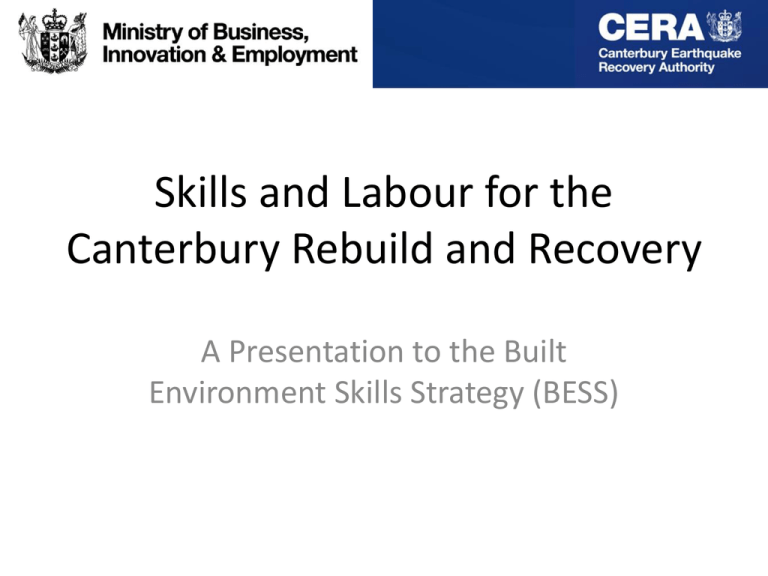Simon Worthington, CERA – Session 5
advertisement

Skills and Labour for the Canterbury Rebuild and Recovery A Presentation to the Built Environment Skills Strategy (BESS) Setting the Scene • More than 10,000 earthquakes have occurred since the first 7.1 magnitude earthquake struck Christchurch on 4 September 2010 • 22 February 2011 earthquake resulted in 185 fatalities and caused widespread damage • Recovering from a natural disaster on this scale in New Zealand is uncharted territory for individuals, communities, businesses, councils and government • Successful recovery requires leadership and partnership between central government, local government, Te Rununga o Ngai Tahu, NGO’s, communities and business 4.35 am 4 Sept 2010 26 Dec 2010 12.51 pm 22 Feb 2011 2.20 pm 13 June 2011 Consequences of the Earthquake • More than 70% of CBD buildings severely damaged • 124 kms of water mains and 300km of sewer pipes damaged • 500,000 tonnes of liquefaction silt removed • 600 kms of roads seriously damaged • 50,000 road surface defects • 55% of secondary students sharing with other schools • 13 out of 36 hotels operating • $25b - $30b estimated cost • 185 lives tragically lost • 459,000 EQC claims (104,000 closed; 355,000 open) Progress So Far • 1,500 workers fixing roads and the • • • • • • three waters 100% of the city has normal reticulated water access 100% of the city has normal kerbside waste services 100% of the city has access to functioning sewerage, chemical toilet or portaloo 92% of parks open 11km of large diameter pressure mains replaced $3.33b paid and 23% EQC claims closed • 600 11kV power cable faults - now repaired • 600+ people in the CBD red zone every day • 1,320 buildings demolished, out of 1,609 • 180,000 homes in green zone • 7,779 residential red zone properties • 6,491 red zone owners have purchase offers • 5,834 homeowners have signed S&P Agreements • 37 zoning decisions remaining Understanding the Need • A futures model has been developed that considers the work generated by the rebuild and also the ongoing activity of the regional economy • It is important to remember…… The model shows the consequences of a defined scenario – it DOES NOT predict the future! Model History • Originally developed to understand the implications of workforce growth / decline as a result of economic changes. • Adapted following the September 2010 earthquake to understand the implications of the earthquake on the local labour market. • Now informing our understanding of the dynamics of the rebuild and when labour may constrain the pace of rebuild. Developing the Intelligence • • • • • • Insurers Project Management Offices Construction Sector Government Developers Community Central City Blueprint Scale of Demand • The total cost of the rebuild, based on current estimates is around $30bn • Approximately this equates to – Residential – 40% – Infrastructure – 10% – Government – 10% – Capital Assets – 10% – Commercial – 30% Operating in a dynamic environment with little certainty • There is still a large degree of uncertainty in the marketplace – When will the rebuild really get underway? – How big will it get? – Will insurance continue to cause delays? – Can we really find all the workers we need? • The outputs of the model are de risked by applying a range of scenarios that give the most likely consequence of future demand. Business As Usual • The earthquakes have had an effect on the normal activity in the region. • Normally the workforce undertakes this BAU activity However • Things have changed • Normal activity is not what it was prior to the earthquakes • There is lots of new activity as a direct or indirect effect of the earthquake Consensus Scenario % of BAU 60% Timeframe - Residential Repairs 0% - Commercial Infrastructure 30% 20% - Residential New Build BAU with Reduction Infrastructure Residential New Builds Residential Repair Commercial Public Commercial Private 2020 Q4 2020 Q3 2020 Q2 2020 Q1 2019 Q4 2019 Q3 2019 Q2 2019 Q1 2018 Q4 2018 Q3 2018 Q2 2018 Q1 2017 Q4 2017 Q3 2017 Q2 2017 Q1 2016 Q4 2016 Q3 2016 Q2 2016 Q1 2015 Q4 2015 Q3 2015 Q2 2015 Q1 2014 Q4 2014 Q3 2014 Q2 2014 Q1 2013 Q4 2013 Q3 2013 Q2 2013 Q1 2012 Q4 2012 Q3 2012 Q2 2012 Q1 2011 Q4 2011 Q3 2011 Q2 2011 Q1 2010 Q4 2010 Q3 2010 Q2 Construction Labour Requirements for Rebuild Activity 35,000 30,000 25,000 BAU Construction Activity 20,000 15,000 10,000 5,000 0 Delayed Rebuild Scenario % of BAU 60 Timeframe + 2 years Residential Repairs 0 + 2 years Commercial Infrastructure 30 20 + 2 years + 2 years Residential New Build BAU with Reduction Infrastructure Residential New Builds Residential Repair Commercial Public Commercial Private 2020 Q3 2020 Q2 2020 Q1 2019 Q4 2019 Q3 2019 Q2 2019 Q1 2018 Q4 2018 Q3 2018 Q2 2018 Q1 2017 Q4 2017 Q3 2017 Q2 2017 Q1 2016 Q4 2016 Q3 2016 Q2 2016 Q1 2015 Q4 2015 Q3 2015 Q2 2015 Q1 2014 Q4 2014 Q3 2014 Q2 2014 Q1 2013 Q4 2013 Q3 2013 Q2 2013 Q1 2012 Q4 2012 Q3 2012 Q2 2012 Q1 2011 Q4 2011 Q3 2011 Q2 2011 Q1 2010 Q4 2010 Q3 2010 Q2 35,000 Construction Labour Requirements for Rebuild Activity 30,000 25,000 BAU Construction Activity 20,000 15,000 10,000 5,000 0 Labour Supply Proportion of demand met by relocating 2% scenario 5% scenario 7% scenario 10% scenario 19% 35% 44% 55% Proportion of demand met by relocating 2% scenario 5% scenario 7% scenario 10% scenario Carpenters and Joiners 5% 12% 16% 23% Painting Trades Workers 7% 17% 24% 34% Concreters 3% 6% 9% 13% 100% 100% 100% 100% Plasterers 5% 14% 19% 27% Bricklayers and Stonemasons 6% 14% 20% 28% Wall and Floor Tilers 6% 14% 20% 29% Building and Plumbing Labourers 25% 62% 86% 100% Plumbers 13% 34% 47% 67% 100% 100% 100% 100% Electricians 18% 44% 62% 89% Roof Tilers 9% 23% 33% 47% Occupation Other Miscellaneous Labourers Truck Drivers Unconstrained Workforce Accommodation Constrained Workforce 2020 Q4 2020 Q3 2020 Q2 2020 Q1 2019 Q4 2019 Q3 2019 Q2 2019 Q1 2018 Q4 2018 Q3 2018 Q2 2018 Q1 2017 Q4 2017 Q3 2017 Q2 2017 Q1 2016 Q4 2016 Q3 2016 Q2 2016 Q1 2015 Q4 2015 Q3 2015 Q2 2015 Q1 2014 Q4 2014 Q3 2014 Q2 2014 Q1 2013 Q4 2013 Q3 2013 Q2 2013 Q1 2012 Q4 2012 Q3 2012 Q2 2012 Q1 2011 Q4 2011 Q3 2011 Q2 2011 Q1 2010 Q4 2010 Q3 2010 Q2 Additional Workforce for Rebuild - Unconstrained and Constrained by Accommodation Availability (6,000 annual) 20,000 18,000 16,000 14,000 12,000 10,000 8,000 6,000 4,000 2,000 0 Unconstrained Workforce Accommodation Constrained Workforce 2020 Q4 2020 Q3 2020 Q2 2020 Q1 2019 Q4 2019 Q3 2019 Q2 2019 Q1 2018 Q4 2018 Q3 2018 Q2 2018 Q1 2017 Q4 2017 Q3 2017 Q2 2017 Q1 2016 Q4 2016 Q3 2016 Q2 2016 Q1 2015 Q4 2015 Q3 2015 Q2 2015 Q1 2014 Q4 2014 Q3 2014 Q2 2014 Q1 2013 Q4 2013 Q3 2013 Q2 2013 Q1 2012 Q4 2012 Q3 2012 Q2 2012 Q1 2011 Q4 2011 Q3 2011 Q2 2011 Q1 2010 Q4 2010 Q3 2010 Q2 Additional Workforce for Rebuild - Unconstrained and Constrained by Accommodation Availability (4,000 annual) 20,000 18,000 16,000 14,000 12,000 10,000 8,000 6,000 4,000 2,000 0 Unconstrained Workforce Accommodation Constrained Workforce 2020 Q4 2020 Q3 2020 Q2 2020 Q1 2019 Q4 2019 Q3 2019 Q2 2019 Q1 2018 Q4 2018 Q3 2018 Q2 2018 Q1 2017 Q4 2017 Q3 2017 Q2 2017 Q1 2016 Q4 2016 Q3 2016 Q2 2016 Q1 2015 Q4 2015 Q3 2015 Q2 2015 Q1 2014 Q4 2014 Q3 2014 Q2 2014 Q1 2013 Q4 2013 Q3 2013 Q2 2013 Q1 2012 Q4 2012 Q3 2012 Q2 2012 Q1 2011 Q4 2011 Q3 2011 Q2 2011 Q1 2010 Q4 2010 Q3 2010 Q2 Additional Workforce for Rebuild - Unconstrained and Constrained by Accommodation Availability (3,000 annual) 20,000 18,000 16,000 14,000 12,000 10,000 8,000 6,000 4,000 2,000 0 Labour Market Recovery Programme • A joined up approach between government, iwi, business and the community to overcoming systems issues in the Greater Christchurch labour market. • A plan that puts the aspirations of business at the core of what we are trying to achieve. • A once in a lifetime chance to do something a little different – to apply acceleration to usual market forces. Why Do We Need One? • Labour market fragmentation • Government agencies were previously uncoordinated – At a local level provision is heading in multiple directions – No one was looking at the big picture • Some macro conditions are not helpful – Population loss – Wage inflation – Marginalisation of disadvantaged groups • Some sectors will not respond effectively to market needs What Will Be Achieved As A Result Of The Programme? • • • • A consolidated and coordinated plan A vision that provides direction Leadership Clear integration between business need and central government policy • Efficiency gains in funding interventions • Appropriateness of response The Strategic Response Priorities: – Attracting and retaining skilled and talented people in Greater Christchurch – Developing skills and capabilities – Engaging disadvantaged and unconnected groups into work – Enabling better linkages between schools, tertiary providers and businesses – Assisting businesses to achieve improved skills utilisation and labour productivity gains Priority Sectors – Agribusiness – Knowledge Intensive Manufacturing – ICT – Professional Services – Health – Construction Construction Sector Workforce Plan • Flows out of the Recovery Strategy and the Labour Market Recovery Programme • Industry-led, and about what industry can do • Sector leaders group met twice to discuss issues and options (MBIE as scribe) The Burning Issues • Considerable uncertainty about when the rebuild will accelerate • A lack of collaboration and coordination resulting in inefficiencies, which raise costs and compound uncertainties Key Themes 1. 2. 3. 4. Clarifying the scale of the additional labour demand Principles of Cooperation Better Information Establish a Good employer Scheme with a Training Commitment 5. Skill shortages 6. Social issues 7. Health and Safety 8. Accommodation 9. Quality of workforce 10. The Licensed building practitioner scheme How Can You Engage With the Plan? • Very keen to hear ideas of industry led initiatives that will make a difference • Plan will be posted on the Canterbury Employment and Skills Board website at the end of next week – www.cesb.org.nz • Feedback directed to Nick Montague at the Ministry of Business Innovation and Employment – by 1st February 2013 The Canterbury Skills and Employment Hub • An employer-friendly and efficient service to: • give New Zealander the first option for jobs in the rebuild • check the local labour market on behalf of employers • fast-track visa applications where no New Zealander can be found • Free online job matching tool for employers and job seekers. • Skills Brokers engage directly with employers about their needs Skills Hub Website • • • The website is clear, straightforward and easy to use. There is lots of useful information for employers and prospective workers The site will be regularly updated with the latest labour market information that businesses and people can use to make informed choices Contacting the Hub • Hub now open for business • A number of ways to contact the Hub: • • • • 0800 Canhub Email: Canty_skillshub@msd.govt.nz www.opportunitycanterbury.org.nz Visit by a Skills Broker • To be evaluated for applicability to rest of New Zealand Sourcing Labour – An Immigration Response to the Canterbury Rebuild Approvals In Principle • Used where: – you have not yet located a candidate, and/or – you have more than one position vacant • Employer applies for ‘approval in principle’ to recruit workers from offshore. • When approved, employer has confidence that can bring in the people needed for the job. • Immigration NZ are now referring interested employers to the Canterbury Skills and Employment Hub to check if there are any suitable New Zealanders available. The Canterbury Skills Shortage List (CSSL) • Revised early November 2012, live on Show Day • Thirteen occupations added: Solid Plasterer Painting Trades Worker Wall and Floor Tiler Fibrous Plasterer Brick Layer Carpenter Roof Tiler Joiner Glazier Floor finishes Stonemason Drain layer Carpenter and joiner • Note that these are skilled jobs at ANZSCO 3, with qualifications and/or experience Offshore Marketing and Recruitment • Immigration NZ can provide you with support offshore • The London-based marketing team is responsible for putting skilled UK/Irish/Dutch migrants in touch with NZ employers and recruiters. We do this in three ways: 1. 2. 3. Attending events in UK and Europe Supporting NZ employers and their recruitment agents when they are in the UK Providing a web-based forum for NZ employers to meet skilled UK migrants. • The London branch can be contacted by e-mail at: ian.riddle@dol.govt.nz







